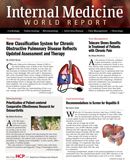Publication
Article
Internal Medicine World Report
The Value of Imaging Studies for Acute, Nonspecific Low Back Pain
Author(s):
When a patient arrives at a hospital or other urgent care center, there are seemingly endless tests that can be undertaken to appropriately diagnose the patient. A recent study reviewed the necessity of some tests, particularly in regard to acute, nonspecific lower back pain.

When a patient arrives at a hospital or other urgent care center, there are seemingly endless tests that can be undertaken to appropriately diagnose the patient. A recent study reviewed the necessity of some tests, particularly in regard to acute, nonspecific lower back pain.
The study, written by Cynthia Smith, MD, medical associate for content development in the medical education division of the American College of Physicians and Patrick Alguire, MD, was published on the website of the Cleveland Clinic.
When studying a 38-year-old man with those complaints, the authors noted for such a vague set of symptoms, imaging tests like radiography, computed tomography (CT) or magnetic resonance imaging (MRI) likely would not prove beneficial and “may expose him unnecessarily to radiation and the anxiety of findings that are clinically insignificant.”
According to their findings, in 2008 alone the cost of treating spine problems was around $86 billion, which put it just $3 billion behind the costs spend on cancer care — representing 9% of total health care costs.
“Spine imaging should be considered only in patients who have a ‘red flag,’ such as advanced age, history of trauma, history of cancer, and prolonged corticosteroid use, all of which have been associated with an increased probably (from 9% to 33%) of either spinal fracture or malignancy,” they wrote.
Other indications for whether spinal imaging is needed, according to the authors, are symptoms such as pain existing longer than 6 weeks, fever, weight loss, and, “progressive neurologic findings on examination.”
The 6-week timetable, the authors noted, was recommended by both the American College of Radiology and the American College of Occupational and Environmental Medicine. The American Pain Society, they reported, recommend against imaging tests for patients with acute and chronic “nonspecific lower back pain,” which they define as pain without any signs of an underlying condition, spinal stenosis, or other direct cause.
Patients who undergo unnecessary scans can be exposed to a variety of undue challenges including excessive amounts of radiation exposure as well as the possibility of “detecting clinically insignificant abnormalities in more than 30% of patients,” the authors said. “These incidental findings increase with age and may lead to additional and possibly unnecessary testing and invasive treatments.”
Both Smith and Alguire noted connections to the pharmaceutical industry.






